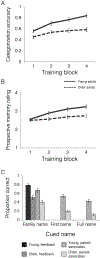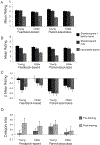Age effects on category learning, categorical perception, and generalization
- PMID: 34762020
- PMCID: PMC9091050
- DOI: 10.1080/09658211.2021.2003818
Age effects on category learning, categorical perception, and generalization
Abstract
Age deficits in memory for individual episodes are well established. Less is known about how age affects another key memory function: the ability to form new conceptual knowledge. Here we studied age differences in concept formation in a category-learning paradigm with face-blend stimuli, using several metrics: direct learning of category members presented during training, generalisation of category labels to new examples, and shifts in perceived similarity between category members that often follow category learning. We found that older adults were impaired in direct learning of training examples, but that there was no significant age deficit in generalisation once we accounted for the deficit in direct learning. We also found that category learning affected the perceived similarity between members of the same versus opposing categories, and age did not significantly moderate this effect. Lastly, we compared traditional category learning to categorisation after a learning task in which a category label (shared last name) was presented alongside stimulus-specific information (unique first names that individuated category members). We found that simultaneously learning stimulus-specific and category information resulted in decreased category learning, and that this decrement was apparent in both age groups.
Keywords: Aging; associative memory; categorical perception; category learning; generalisation.
Conflict of interest statement
The authors declare no competing financial interests.
Figures





Similar articles
-
Perceived similarity ratings predict generalization success after traditional category learning and a new paired-associate learning task.Psychon Bull Rev. 2020 Aug;27(4):791-800. doi: 10.3758/s13423-020-01754-3. Psychon Bull Rev. 2020. PMID: 32472329 Free PMC article.
-
Training set coherence and set size effects on concept generalization and recognition.J Exp Psychol Learn Mem Cogn. 2020 Aug;46(8):1442-1464. doi: 10.1037/xlm0000824. Epub 2020 Feb 27. J Exp Psychol Learn Mem Cogn. 2020. PMID: 32105147 Free PMC article.
-
Coherent category training enhances generalization in prototype-based categories.J Exp Psychol Learn Mem Cogn. 2023 Dec;49(12):1923-1942. doi: 10.1037/xlm0001243. Epub 2023 May 25. J Exp Psychol Learn Mem Cogn. 2023. PMID: 37227877 Free PMC article.
-
Learning new categories in older age: A review of theoretical perspectives and empirical findings.Psychol Aging. 2023 May;38(3):174-187. doi: 10.1037/pag0000715. Epub 2023 Feb 27. Psychol Aging. 2023. PMID: 36848081 Review.
-
Are faces special in Alzheimer's disease? Cognitive conceptualisation, neural correlates, and diagnostic relevance of impaired memory for faces and names.Cortex. 2007 Oct;43(7):898-906. doi: 10.1016/s0010-9452(08)70689-0. Cortex. 2007. PMID: 17941348 Review.
Cited by
-
Multisensory perception constrains the formation of object categories: a review of evidence from sensory-driven and predictive processes on categorical decisions.Philos Trans R Soc Lond B Biol Sci. 2023 Sep 25;378(1886):20220342. doi: 10.1098/rstb.2022.0342. Epub 2023 Aug 7. Philos Trans R Soc Lond B Biol Sci. 2023. PMID: 37545304 Free PMC article. Review.
-
Understanding associative false memories in aging using multivariate analyses.Neuropsychol Dev Cogn B Aging Neuropsychol Cogn. 2022 May;29(3):500-525. doi: 10.1080/13825585.2022.2037500. Epub 2022 Feb 11. Neuropsychol Dev Cogn B Aging Neuropsychol Cogn. 2022. PMID: 35147489 Free PMC article.
-
Category-Biased Neural Representations Form Spontaneously during Learning That Emphasizes Memory for Specific Instances.J Neurosci. 2022 Feb 2;42(5):865-876. doi: 10.1523/JNEUROSCI.1396-21.2021. Epub 2021 Dec 22. J Neurosci. 2022. PMID: 34937702 Free PMC article.
-
The effects of age on category learning and prototype- and exemplar-based generalization.Psychol Aging. 2022 Nov;37(7):800-815. doi: 10.1037/pag0000714. Epub 2022 Oct 10. Psychol Aging. 2022. PMID: 36222646 Free PMC article.
References
Publication types
MeSH terms
Grants and funding
LinkOut - more resources
Full Text Sources
